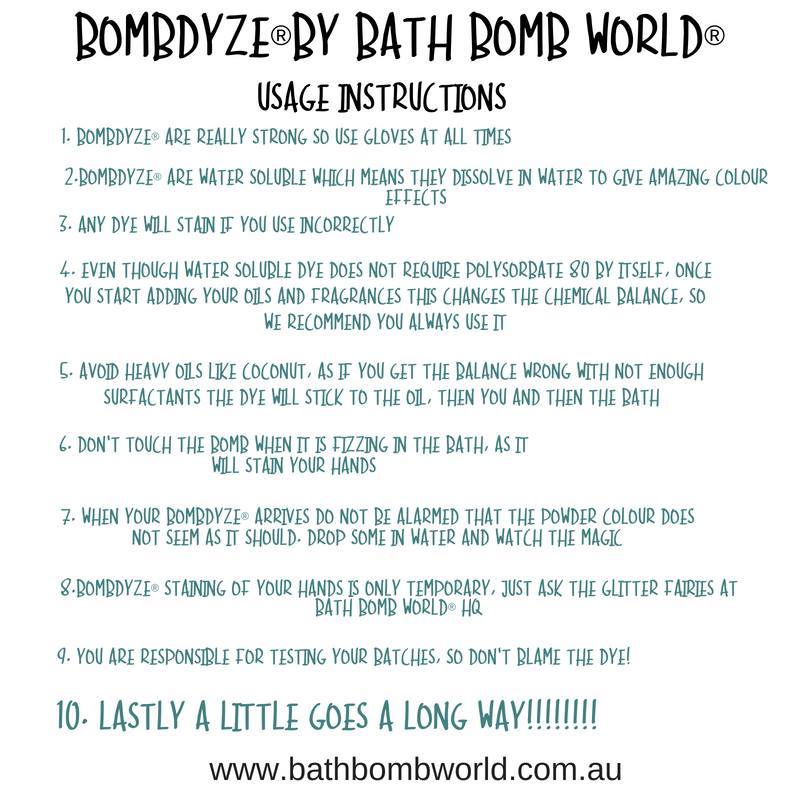Bath Bomb World® Bombdyze® Airdyze™ Lime Sorbet
Weight: 30.00ml
Availability: 99984
FD&C - Water Soluble Air Brush Dye -CI 42090 - 19140

MATERIAL SAFETY DATA SHEET
Product Information:
Non Hazardous
First Aid Measures
Eye Contact: Check for and remove any contact lenses. In case of contact, immediately flush eyes with plenty of water for at least 15 minutes. Cold water may be used. Get medical attention if irritation occurs.
24 Hour Emergency Number
Product Name: Brilliant Blue.
CAS No: 3844-45-9
CI#: 42090
Synonony: CI Food Blue 2, FD&C Blue 1
Chemical Name: Disodium α‐(4‐(N‐ethyl‐3‐sulfonatobenzylamino) phenyl)‐α‐(4‐N‐ethyl‐3‐sulfonatobenzylamino) cyclohexa‐2,5‐dienylidene) toluene‐2‐ sulfonate
Chemical Formula: C37H34N2Na2O9S3
Skin Contact: Wash with soap and water. Cover the irritated skin with an emollient. Get medical attention if irritation develops. Cold water may be used.
Serious Skin Contact: Not available.
Inhalation: If inhaled, remove to fresh air. If not breathing, give artificial respiration. If breathing is difficult, give oxygen. Get medical attention.
Serious Inhalation: Not available.
Ingestion: Do NOT induce vomiting unless directed to do so by medical personnel. Never give anything by mouth to an unconscious person. Loosen tight clothing such as a collar, tie, belt or waistband. Get medical attention if symptoms appear.
Serious Ingestion: Not available.
Section 5:- Fire and Explosion Data
Flammability of the Product: May be combustible at high temperature.Auto-Ignition Temperature: Not available.
Flash Points: Not available.
Flammable Limits: Not available.
Products of Combustion: These products are carbon oxides (CO, CO2), nitrogen oxides (NO, NO2...), sulfur oxides (SO2,SO3...).
Fire Hazards in Presence of Various Substances: Slightly flammable to flammable in presence of heat.
Explosion Hazards in Presence of Various Substances: Risks of explosion of the product in presence of mechanical impact: Not available. Risks of explosion of the product in
presence of static discharge: Not available.
Fire Fighting Media and Instructions: SMALL FIRE: Use DRY chemical powder. LARGE FIRE: Use water spray, fog or foam. Do not use water jet.
Special Remarks on Fire Hazards: As with most organic solids, fire is possible at elevated temperatures
Special Remarks on Explosion Hazards: Not available.
Section 6:- Accidental Release Measures
Small Spill:
Use appropriate tools to put the spilled solid in a convenient waste disposal container. Finish cleaning by spreading water on the contaminated surface and dispose of according to local and regional authority requirements.
Large Spill:
Use a shovel to put the material into a convenient waste disposal container. Finish cleaning by spreading water on the contaminated surface and allow to evacuate through the sanitary system.
Section 7:- Handling and Storage
Precautions:
Keep away from heat. Keep away from sources of ignition. Ground all equipment containing material. Do not ingest. Do not breathe dust. If ingested, seek medical advice immediately and show the container or the label.
Storage:
Keep container tightly closed. Keep container in a cool, well-ventilated area.
Section 8:- Exposure Controls/Personal Protection
Engineering Controls:
Use process enclosures, local exhaust ventilation, or other engineering controls to keep airborne levels below recommended exposure limits. If user operations generate dust, fume or mist, use ventilation to keep exposure to airborne contaminants below the exposure limit.
Personal Protection:
Safety glasses. Lab coat. Dust respirator. Be sure to use an approved/certified respirator or equivalent. Gloves.
Personal Protection in Case of a Large Spill:
Splash goggles. Full suit. Dust respirator. Boots. Gloves. A self contained breathing apparatus should be used to avoid inhalation of the product. Suggested protective clothing might not be sufficient; consult a specialist BEFORE handling this product.
Exposure Limits:
Not available.
Section 9:- Physical and Chemical Properties
Physical state and appearance: Solid Fine Powder or Granules.
Odor: No Characteristic Odor.
Taste: Mildly Salty.
Molecular Weight: 792,84 g/mole
Color: Dark Blue.
pH: 5-6.
Boiling Point: Not available.
Melting Point: Decomposes.
Critical Temperature: Not available.
Specific Gravity: Not available.
Vapor Pressure: Not applicable.
Vapor Density: Not available.
Volatility: Not available.
Odor Threshold: Not available.
Water/Oil Dist. Coeff.: Not available.
Ionicity (in Water): Not available.
Solubility: Easily soluble in cold water, hot water.
Section 10:- Stability and Reactivity Data
Stability: The product is stable.
Instability Temperature: Not available.
Conditions of Instability: Not available.
Incompatibility with various substances: Not available.Corrosivity: Not considered to be corrosive for metals and glass.Special Remarks on Reactivity: Not available.
Special Remarks on Corrosivity: Not available.Polymerization: Will not occur.
Section 11:- Toxicological Information
Routes of Entry: Absorbed through skin. Eye contact.
Toxicity to Animals: Not available.
Chronic Effects on Humans: Not available.
Other Toxic Effects on Humans: Slightly hazardous in case of skin contact (irritant, permeator), of ingestion, of inhalation.
Special Remarks on Toxicity to Animals: Not available.
Special Remarks on Chronic Effects on Humans: Not availableSpecial Remarks on other Toxic Effects on Humans: Not available.
Section 12:- Ecological Information
Ecotoxicity: Not available.
BOD5 and COD: Not available.
Products of Biodegradation:
Possibly hazardous short term degradation products are not likely. However, long term degradation products may arise.
Toxicity of the Products of Biodegradation: The product itself and its products of degradation are not toxic.
Special Remarks on the Products of Biodegradation: Not available.
Waste Disposal:
Waste must be disposed of in accordance with federal, state and local environmental control regulations.
Section 14:- Transport InformationIdentification: Not applicable.
Special Provisions for Transport: Not applicable. Section 15:- Other Regulatory Information
Manufactured as per specification set by E.C./U.S. FDA/JECFA. Each country has its own laws on colouring of food-stuffs, colourant permitted and their purity standards.










